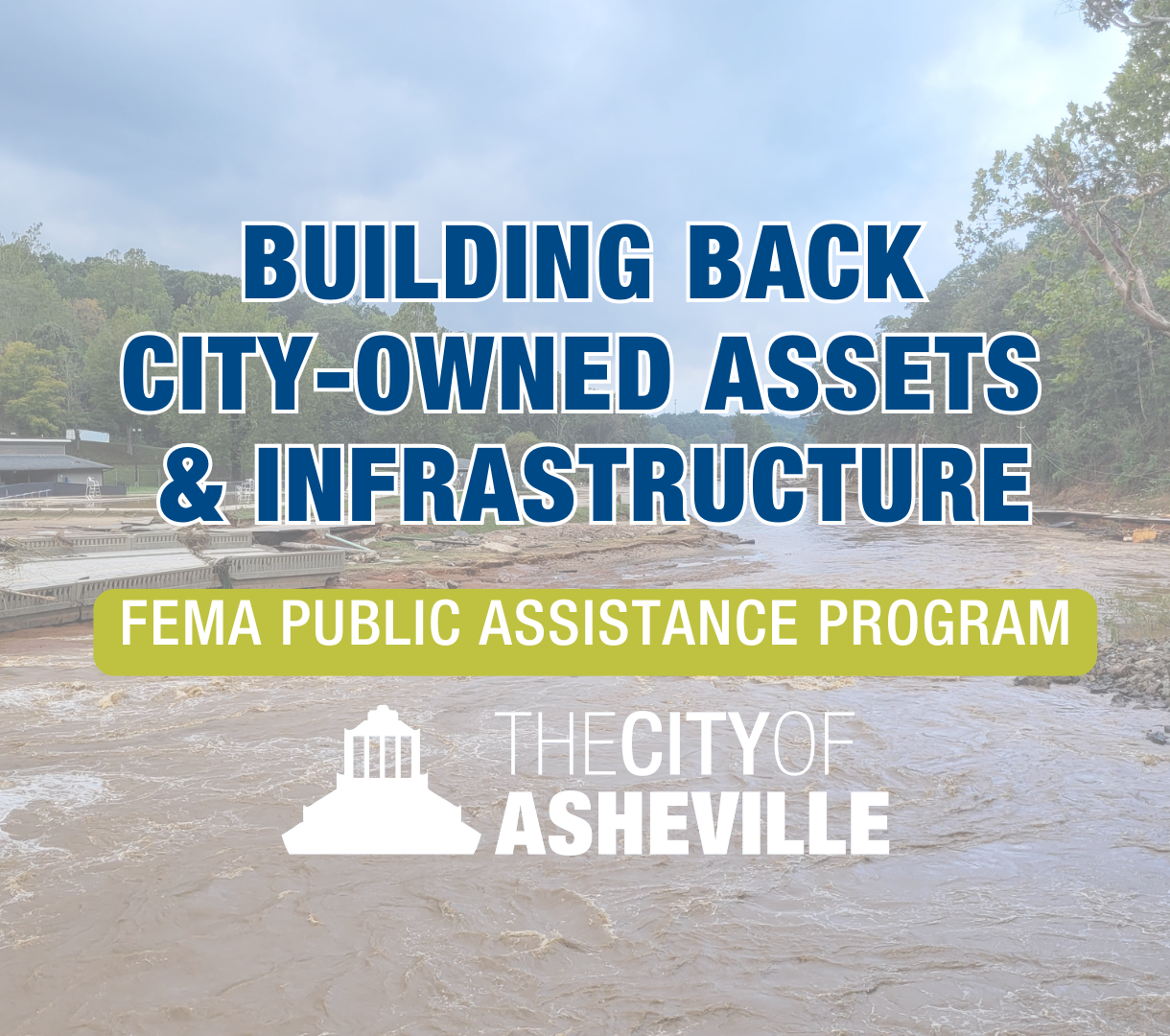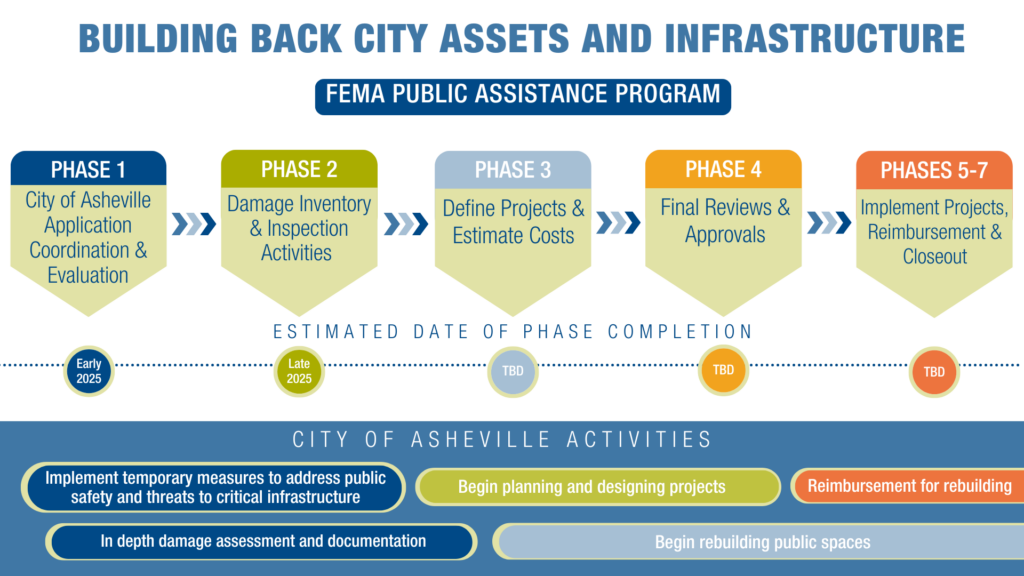The City of Asheville experienced an estimated $1 billion in damage to City-owned property and assets due to Helene. This includes extensive damage to City-owned parks, streets, buildings, utilities, and other vital assets and infrastructure. Rebuilding will be a massive undertaking, and this is not something the City can fund on its own. Federal and state funds are crucial in order to restore our beloved public spaces.
FEMA has a process in place for reimbursing government and some nonprofit agencies for costs incurred to rebuild after natural disasters through the FEMA Public Assistance program. This program is for public property; not individuals or businesses in the community. The City of Asheville is preparing to maximize use of this program, in addition to other funding sources, to restore the City’s infrastructure and public spaces damaged by Helene. While this is a critical funding stream for rebuilding City infrastructure, it is important to note this funding is mostly oriented toward rebuilding structures similar to the ones that existed before the storm. There are also FEMA funding programs for mitigation and resilience. Using these sources of funding along with other funding streams projects will be reconstructed to include include significant improvements (e.g., resiliency, new amenities).
The below graphic provides an overview of the process for rebuilding Asheville’s public spaces through the FEMA Public Assistance program.
The City of Asheville initiated Phase 1 of the FEMA Public Assistance process immediately after the storm, allocating as much staff time as possible given demanding emergency response efforts.
The transition to Phase 2 is underway and includes FEMA damage inventory and inspections of City-owned property that experienced storm damage.
Throughout the first two phases, the City is implementing safety measures and making temporary repairs to roads, parks, and buildings wherever possible. Given the vast amount of damage to City-owned property and assets, Phase 2 is expected to last through late 2025.
The City’s initial storm damage inventory indicates impacts at:
- 23 facilities, including community centers, communication towers, fire stations, restrooms and maintenance buildings
- 22 parks and entertainment facilities
- 6 greenways
- 200+ roadway sites including but not limited to streets, bridges, sidewalks, landslides and stormwater infrastructure.
While properties and assets are inspected, the City can begin work on planning and design for rebuilding projects concurrently as feasible.
Phase 3 will involve City coordination with FEMA to determine funding eligibility for each individual rebuilding project, which will be approved in Phase 4.
Although Phases 3 and 4 may take some time to complete, the City will begin immediately rebuilding where possible. In addition to storm recovery projects, the City will also be engaged in regular capital projects and projects that were identified in the 2024 bond referendum.
Phases 5 through 7: Once all cost estimates and scoping are reviewed and approved for each recovery project, FEMA will disburse federal funds to the State of North Carolina, which will manage program funds for all Public Assistance applicants of the Helene disaster statewide. The State will then reimburse the City of Asheville for eligible expenses incurred.
Throughout the duration of the rebuilding process, the City of Asheville will be required to coordinate with the State to provide quarterly updates to FEMA. The final phase of the program includes formal closeout upon completion of projects.
Questions and Answers
Why do our public spaces look like little has been done in terms of clean up and rebuilding?
The City has been working with FEMA to engage in comprehensive official damage assessments and site inspections. It is optimal for FEMA inspectors to be able to physically see the damage in order to estimate the cost of rebuilding. The City of Asheville is implementing emergency safety measures in storm damaged areas and continues to make temporary repairs allowing the reopening of parks, streets, and facilities where possible.
What is the City doing to make sure the FEMA Public Assistance process goes smoothly and efficiently?
Hundreds of hours of staff time in the aftermath of the storm has been spent proactively documenting damages. Though this is not required by FEMA, these activities will expedite FEMA’s process and ensure that the City has its own assessment of the extent of the damage, which reduces potential to be underfunded for rebuilding projects.
Why does this process take so long?
The FEMA Public Assistance Program is a thorough process because this federal agency must maintain responsible stewardship of public dollars. Cost recovery through FEMA will be the main source of funding enabling the City to rebuild, so going through the process is necessary. Secondly, designing and building parks, streets, buildings, and water mains takes time. While the restoration of the water main connecting to North Fork in the immediate aftermath of the storm was completed relatively quickly, this was an outstanding accomplishment that required a massive amount of resources in what was considered an emergency construction project. Rebuilding public spaces in our community will take years. Each individual project will be completed on a timeline that is reasonable and typical for the project type.
Does this change timelines for City projects that weren’t impacted by Helene?
The City is working to keep active capital project schedules on track as much as possible in addition to planning for recently approved General Obligation Bond projects. Projects in areas that were not impacted by the storm and where construction would not inhibit economic recovery are moving forward with minimal storm-related delay.
How can I stay informed and provide input on how our community is rebuilt?
Community input is very important and will be ongoing in the recovery process, especially for rebuilding in areas with more complexity.
- In late 2024, the City of Asheville launched the Asheville Recovers Engagement Hub, providing a space for community members to join the recovery conversation.
- The Recovery Priority Survey was launched on January 16, 2025, and will remain open until February 2, 2025. The results will be shared with the City Council ahead of their retreat on February 13 and 14, 2025 where they will consider how to address needs identified by the community.
- Storm related infrastructure impacts were the focus of City Council’s January 23, 2025, Storm Recovery Briefing, which can be streamed on the City’s YouTube channel.
The order in which rebuilding takes place is primarily dependent on policy guidance led by Asheville City Council, which will drive the operational activities directed by the City Manager. Additionally, rebuilding timelines will largely depend on cost recovery and immediate needs.
As storm recovery projects start to take shape, stay tuned for public input opportunities.
Is this the same FEMA program that helps residents?
FEMA provides two main types of assistance after a major Presidentially declared disaster: Individual Assistance and Public Assistance. The Individual Assistance program benefits individuals and households while the Public Assistance program benefits communities. Visit the FEMA website for more information.


